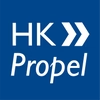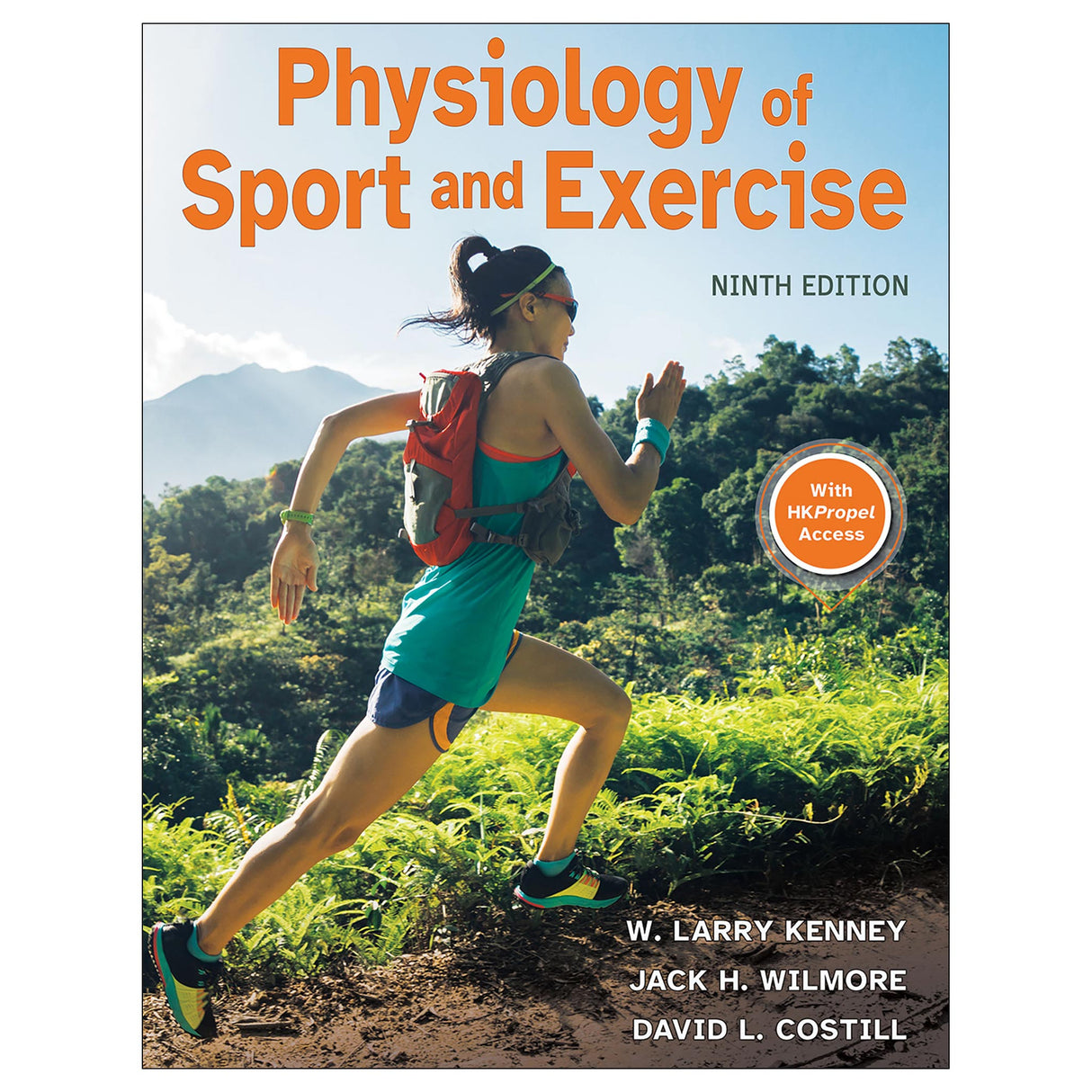Physiology of Sport and Exercise 9th Edition Ebook With HKPropel Access
$126.00 USD

Written by a team of distinguished researchers, all past presidents of the American College of Sports Medicine, this ninth edition has been updated based on the most recent standards and guidelines in the field of exercise physiology. It continues its rich tradition of offering superior illustrations, photos, and medical artwork with a modern look to encourage a deep understanding of complex topics.
Related multimedia components delivered through HKPropel further enrich the learning experience: 26 animations and 66 audio clips offer explanations of elaborate physiological processes. More than 30 video clips feature leaders in the field discussing central topics, including several new clips to help students connect theoretical and practical concepts. The digital elements have been refreshed and modernized for this edition, and QR codes throughout the text help you reach the content quickly.
Various types of online learning activities, key term flash card reviews, and key term quizzes offer interactive opportunities to engage with the content, including the ability for instructors to assign and track progress directly through HKPropel. Chapter quizzes may also be assigned; these are automatically graded in order to test comprehension of critical concepts.
In addition to a refreshed chapter-opening format that draws readers in, Physiology of Sport and Exercise, Ninth Edition, incorporates the latest research in the field:
- New content on energy sources used in exercise
- Expanded content on fatigue and exercise performance
- Expanded coverage of the interactive effects of insulin and exercise
- More detail on lactate threshold and lactate shuttle
- Content on the role of vascular changes in skeletal muscle health and function
- Updated Research Perspective sidebars, including over 60 new sidebars, that emphasize emerging findings in the field
Physiology of Sport and Exercise has been a pivotal textbook in the field of exercise physiology. The ninth edition offers dynamic and interactive learning activities, easy-to-follow layouts, and research-oriented content enriched with visual supplements.
Note: A code for accessing HKPropel is included with this ebook.
Audience
Textbook for undergraduate courses in exercise physiology. A reference for exercise scientists, sports medicine specialists, physicians, athletic trainers, personal trainers, physical therapists, physical educators, fitness specialists, and graduate students in exercise science.An Introduction to Exercise and Sport Physiology
Focus of Exercise and Sport Physiology
Acute and Chronic Responses to Exercise
The Evolution of Exercise Physiology
Exercise Physiology in the 21st Century
Research: Turning Curiosity Into Science
Part I. Exercising Muscle
Chapter 1. Structure and Function of Exercising Muscle
Anatomy of Skeletal Muscle
Muscle Fiber Contraction
Muscle Fiber Types
Skeletal Muscle and Exercise
Chapter 2. Fuel for Exercise: Bioenergetics and Muscle Metabolism
Energy Substrates
Controlling the Rate of Energy Production
Storing Energy: High-Energy Phosphates
The Basic Energy Systems
Interaction of the Energy Systems
The Crossover Concept
The Oxidative Capacity of Muscle
Chapter 3. Neural Control of Exercising Muscle
Structure and Function of the Nervous System
Central Nervous System
Peripheral Nervous System
Sensory-Motor Integration
Chapter 4. Hormonal Control During Exercise
The Endocrine System
Endocrine Glands and Their Hormones: An Overview
Hormonal Regulation of Metabolism During Exercise
Hormonal Regulation of Fluid and Electrolytes During Exercise
Hormonal Regulation of Caloric Intake
Growth Hormone and Testosterone
Part II. Energy Expenditure and Fatigue
Chapter 5. Energy Expenditure
Measuring Energy Expenditure
Estimating Energy Expenditure
Predicting Energy Expenditure
Energy Expenditure at Rest and During Exercise
Chapter 6. Fatigue, Muscle Soreness, and Muscle Cramps
Fatigue and Its Causes
Critical Power: The Link Between Energy Expenditure and Fatigue
Muscle Soreness
Exercise-Induced Muscle Cramps
Part III. Cardiovascular and Respiratory Function
Chapter 7. The Cardiovascular System and Its Control
The Heart
The Vascular System
Blood
Chapter 8. The Respiratory System and Its Regulation
Pulmonary Ventilation
Pulmonary Volumes
Pulmonary Diffusion
Transport of Oxygen and Carbon Dioxide in the Blood
Gas Exchange at the Muscles
Regulation of Pulmonary Ventilation
Afferent Feedback From Exercising Limbs
Exercise Training and Respiratory Function
Chapter 9. Cardiorespiratory Responses to Acute Exercise
Cardiovascular Responses to Acute Exercise
Respiratory Responses to Acute Exercise
Recovery From Acute Exercise
Part IV. Exercise Training
Chapter 10. Principles of Exercise Training
Terminology
General Principles of Training
Resistance Training Programs
Anaerobic and Aerobic Power Training Programs
Chapter 11. Adaptations to Resistance Training
Resistance Training and Gains in Muscular Fitness
Mechanisms of Gains in Muscle Strength
Interaction Between Resistance Training and Diet
Resistance Training for Special Populations
Chapter 12. Adaptations to Aerobic and Anaerobic Training
Adaptations to Aerobic Training
Adaptations to Anaerobic Training
Adaptations to High-Intensity Interval Training
Specificity of Training and Cross-Training
Chapter 13. Prescription of Exercise for Health and Fitness
Health Benefits of Regular Physical Activity and Exercise
Exercise and Cognitive Function
Physical Activity Recommendations
Health Screening
Exercise Prescription
Sedentary Behavior
Monitoring Exercise Intensity
Exercise Programming
Exercise and Rehabilitation of People with Diseases
Part V. Environmental Influences on Performance
Chapter 14. Exercise in Hot and Cold Environments
Body Temperature Regulation
Physiological Responses to Exercise in the Heat
Health Risks During Exercise in the Heat
Acclimation to Exercise in the Heat
Exercise in the Cold
Physiological Responses to Exercise in the Cold
Health Risks During Exercise in the Cold
Chapter 15. Altitude, Hyperbaric Environments, and Microgravity
Environmental Conditions at Altitude
Physiological Responses to Acute Altitude Exposure
Exercise and Sport Performance at Altitude
Acclimation: Chronic Exposure to Altitude
Altitude: Optimizing Training and Performance
Health Risks of Acute Exposure to Altitude
Hyperbaric Environments
Microgravity
Part VI. Optimizing Performance in Sport
Chapter 16. Training for Sport
Optimizing Training
Periodization of Training
Overtraining
Tapering for Peak Performance
Detraining
Chapter 17. Nutrition, Body Composition, and Obesity
Classification of Nutrients
Water and Electrolyte Balance
Nutrition and Athletic Performance
Assessing Body Composition
Body Composition, Weight, and Sport Performance
Obesity
Weight Loss Management Guidelines
Role of Physical Activity in Weight Management and Risk Reduction
Chapter 18. Ergogenic Aids in Sport
Researching Ergogenic Aids
Ergogenic Aids with Established Evidence of Efficacy
Ergogenic Aids with Emerging Evidence of Efficacy
Prohibited Substances and Techniques
Part VII. Special Considerations in Sport, Exercise, and Physical Activity
Chapter 19. Children and Adolescents in Sport and Exercise
Growth, Development, and Maturation
Physiological Responses to Acute Exercise
Physiological Adaptations to Exercise Training
Physical Activity Patterns Among Youth
Physical Activity Recommendations for Children and Adolescents
Sport Performance and Specialization
Special Issues
Chapter 20. Aging in Sport and Exercise
Height, Weight, and Body Composition
Physiological Responses to Acute Exercise
Physiological Adaptations to Exercise Training
Recommended Physical Activity
Sport Performance
Special Issues
Chapter 21. Sex Differences in Sport and Exercise
Sex Versus Gender in Exercise Physiology
Body Size and Composition
Physiological Responses to Acute Exercise
Physiological Adaptations to Exercise Training
Sport Performance
Special Issues
Chapter 22. Cardiovascular Disease and Physical Activity
Prevalence of Cardiovascular Disease
Forms of Cardiovascular Disease
Understanding the Disease Process
Cardiovascular Disease Risk
Reducing Risk Through Physical Activity
Risk of Heart Attack and Death During Exercise
Exercise Training and Rehabilitation of Patients with Heart Disease
Does the Anti-Diabetic Agent Metformin Prevent the Beneficial Effects of Exercise?
Health Risks of Hyperbaric Environments
Precooling and Sport Performance




All ancillaries are free to adopting instructors through HKPropel.
Instructor guide. Includes a sample syllabus, selected Internet links, and a set of eight laboratory exercises. Each chapter guide begins with an overview of the book learning cycle and includes a detailed lecture outline, student assignments, an overview of the online chapter activities, and an overview of the available multimedia content.
Test package. Contains more than 1,650 questions in true-false, fill-in-the-blank, essay and short-answer, and multiple-choice formats. The files may be downloaded for integration with a learning management system or printed for use as paper-based tests. Instructors may also create their own customized quizzes or tests from the test bank questions to assign to students directly through HKPropel. Multiple-choice and true-false questions are automatically graded, and instructors can review student scores in the platform.
Chapter quizzes. Contains ready-made quizzes to assess student comprehension of the most important concepts in each chapter. Each quiz may be downloaded or assigned to students directly through HKPropel. The chapter assessments are automatically graded, and instructors can review student scores in the platform.
Presentation package. Features more than 1,240 PowerPoint slides of text, artwork, and tables from the book that can be used for class discussion and presentation. The slides in the presentation package can be used directly within PowerPoint or printed to make handouts for students. Instructors can easily add, modify, and rearrange the order of the slides.
Image bank. Includes most of the figures, content photos, and tables from the text, sorted by chapter. These can be used in developing a customized presentation based on specific course requirements.
The presentation package plus image bank is also available for purchase • ISBN 978-1-7182-3243-3
Instructors also receive access to all student materials in HKPropel. For Physiology of Sport and Exercise, Ninth Edition, this includes 26 animations, 66 audio clips, and over 30 video clips. Various types of online learning activities, key term flash card reviews, and key term quizzes offer students interactive opportunities to engage with the content—all of which can be assigned, and progress tracked, by instructors directly through HKPropel. In addition, chapter quizzes may also be assigned; these are automatically graded to test comprehension of critical concepts.







